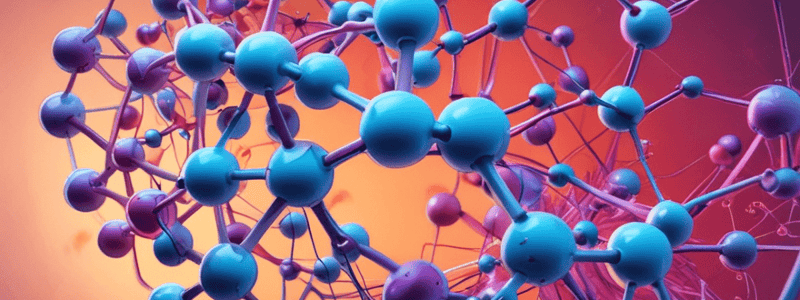Podcast
Questions and Answers
What is the defining feature of an aldehyde?
What is the defining feature of an aldehyde?
A substituent on the carbon atom next to the carbonyl carbon
Give an example of a simple aldehyde.
Give an example of a simple aldehyde.
Formaldehyde (CH2O)
Why are ketones less reactive compared to aldehydes?
Why are ketones less reactive compared to aldehydes?
Due to their electron-donating alkyl groups, which makes them more stable and less likely to react with nucleophiles.
What are the characteristics of carboxylic acids?
What are the characteristics of carboxylic acids?
What functional groups are present in carboxylic acids?
What functional groups are present in carboxylic acids?
How can carboxylic acids be synthesized?
How can carboxylic acids be synthesized?
How are amines classified?
How are amines classified?
What distinguishes a ketone from an aldehyde in terms of bonding at the carbonyl carbon?
What distinguishes a ketone from an aldehyde in terms of bonding at the carbonyl carbon?
Give an example of an ether compound.
Give an example of an ether compound.
Why are aldehydes important starting materials for many organic syntheses?
Why are aldehydes important starting materials for many organic syntheses?
What is the simplest ether compound?
What is the simplest ether compound?
What is the role of amines in chemical reactions?
What is the role of amines in chemical reactions?
Flashcards are hidden until you start studying
Study Notes
Organic chemistry is the branch of chemistry dealing with the study of carbon compounds and their properties, reactions, and synthesis. It includes several classes of organic molecules that play crucial roles in various chemical processes and biological systems. This article explores five major types of organic molecular structures: aldehydes, ketones, carboxylic acids, amines, and ethers.
Aldehydes
An aldehyde is a compound containing a carbonyl group (-C=O) attached to a hydrocarbon group. They are characterized by having a substituent on the carbon atom next to the carbonyl carbon. The simplest aldehyde is formaldehyde (CH2O), but larger molecules such as propanal (CH3CH2CHO) and benzaldehyde (C6H5CHO) also exist. Aldehydes are important starting materials for many organic syntheses because they can undergo various reactions, including nucleophilic addition and oxidation.
Ketones
A ketone is similar to an aldehyde, except the carbonyl carbon is not bonded to a hydrogen atom. Instead, there are two alkyl or aryl groups bonded to the carbonyl carbon. For example, acetone (CH3COCH3) and methyl vinyl ketone (CH3C(=O)CH2CH2OH) are common ketones. Ketones have lower reactivity compared to aldehydes due to their electron-donating alkyl groups, which makes them more stable and less likely to react with nucleophiles.
Carboxylic Acids
Carboxylic acids contain a carbonyl group (C=O) bonded to a hydroxyl group (OH). These acids are characterized by their acrid taste and their ability to conduct electricity in aqueous solutions. Examples include formic acid (HCOOH), acetic acid (CH3COOH), and salicylic acid (C6H4(OH)COOH). Carboxylic acids can be synthesized by various methods, including the reaction of aldehydes or ketones with alcohols or ammonia, and they play a significant role in many chemical processes.
Amines
An amine is a compound that contains a nitrogen atom bonded to a hydrogen atom and other atoms or groups of atoms, such as alkyl or aryl groups. They are characterized by their basic properties and their ability to form hydrogen bonds. Amines are classified into primary (NH2), secondary (NH(CH3)), and tertiary (N(CH3)2) based on the number of alkyl groups bonded to the nitrogen atom. Aniline (C6H5NH2) is an example of an amine. Amines play a significant role in many chemical reactions, including catalysis, polymerization, and pharmaceutical synthesis.
Ethers
An ether is a compound containing an oxygen atom bonded to two alkyl or aryl groups. The simplest ether is diethyl ether (CH3CH2OCH2CH3), and other examples include ethyl vinyl ether (CH3CH2OCH=CH2) and anisole (C6H5OCH3). Ethers are characterized by their low reactivity and their ability to dissolve nonpolar organic compounds. They are used as solvents in various chemical processes and in the production of polymer materials.
In conclusion, organic chemistry encompasses a wide range of molecules with diverse properties and applications. Understanding the structures and reactions of aldehydes, ketones, carboxylic acids, amines, and ethers is crucial for developing new organic syntheses and exploiting these compounds in various industries.
Studying That Suits You
Use AI to generate personalized quizzes and flashcards to suit your learning preferences.




